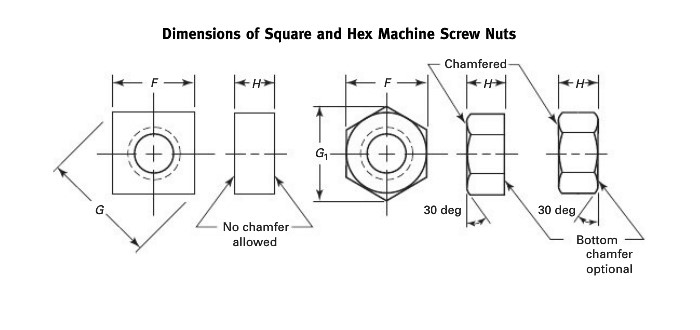
Supply Chain Disruption
On the way to a client’s office, I was listening to NPR. The discussion was about the virus in China with the impact on the supply chain. Specifically, the pressure this health crisis would have on the supply chain presently, and in the long term. Perhaps the most important as the disease spans the globe, is the long-term response from the supply chain, specifically the United States, and the proposal to bringing more manufacturing back.
The difficulty in procuring a product or subassembly depends upon the type of product. For example, standard screws and nuts (for example, ASME B18.2.2 Square and Hex Machine Screw Nut) are perhaps easier to come by from across the globe as these components are not custom tooled to a single customer but for mass consumption. However, even this has grades of metal and strengths that makes ordering not as simple as physical dimensions.
The problem is not that there are health issues underway in China, in fact, as we see, the contagion has spread across the world to varying degrees. The true issue is long term and having a high proportion of any manufacturing in any one geographic location or at one company. For example, let’s imagine that all manufacturing of integrated circuits originated from the United States (as it once did). Imagine further that an epidemic or any disruption happened in the United States. In this instance, the integrated circuit supply chain would likely be severely impacted. One location means a disaster in that one location, and it need not be viral, but environmental, any large enough disruption.
All Our Eggs in One Basket
We are not going to dwell on these standard parts, there are plenty of manufacturer and distributor for these standard parts, but those custom constituent parts that or parts that are custom made entirely in one geography. Parts that have single source, or can only be obtained from one locale, is like the proverbial eggs in one basket. Once the basket carrying our eggs breaks, the solution is not to put all your eggs into another basket, but to put some eggs in different baskets, or diversification, but changing the supply chain does not happen overnight. There may be other areas of the world a product or part can be obtained, there may be other suppliers or substitute product or parts.
Learning this all our eggs in one basket or worrying about this after a disaster strikes is largely pointless. To be resilient to these emergent transients will require a productive exploration of the risks to the supply chain and mitigation before the event happened. Part of the set up of the supply chain could consider alternative approaches. We could have explored, for example, multiple suppliers in different regions, 3D printing of parts, and substitute or alternative material use for the product. If our product requires special tooling or processes, we could have built a secondary tool (perhaps a soft tool, that is a tool is made from pre-hardened steel lower cost, smaller production volume) to make this economically palatable.
Value Proposition
Producing a product, requires an exploration of value to the customer or client. There are always cost pressures, on the organizations to provide the best value for the customer or clientele. The typical value equation:
Value = Benefit – Cost
To include some of these alternative approaches above for example second suppliers, perhaps this value proposition should consider the cost of being more resilient to these unpredictable events:
Value = Benefit – (Product Cost + Resiliance Cost)
If our organization obtains or receives components or assemblies from lower tiered suppliers, it will serve the organization well to have company policies in place to provide a focus, prioritizing resiliency as part of the any work of the organization. For example, the product development and the organization’s procurement and project management activities, will have processes and actions to assure the organization reduces this risk due to these failures. A project that has the scope of delivering a new product or sub-assembly for a product, the project scope may be to develop other alternatives for material acquisition, or at least identify alternative solutions and record these for posterity. This additional scope to the project may require additional time for exploration into alternative production sites (different region or country) within the same supplier or perhaps additional suppliers.
If the supply chain is important, we cannot wait to the last minute to explore how we will adapt in the case of an emergency. However, the onus for addressing these supply chain issues is not entirely on the individual suppliers in the supply chain. In fact, this is more of an aggregation of the supply chain. There are consequences for these business decisions and perhaps government interventions. For example, there was a time when integrated circuit manufacturing was highest in the United States, now the top 3 countries are from Asia (Taiwan, South Korea and China).
The migration of any industry to a single favorable region, is not a risk that is born out of the single action of one company, but the actions of an industry at large. The individual actions are benign, but collectively this natural gravitation puts the supply chain at risk. Risk, as in uncertainty. As countries or regions become the core for certain products, so too the risk in the event of a disruption event that will disrupt the supply chain significantly, like we are seeing presently with the Coronavirus.
You might think that the company can just purchase massive quantities of inventory. There are a couple of risks or downsides to doing so. The first associated with product quality or changes that are born from external events such as the customer’s interaction with the product. Large volume of product that may require modification will require rework, and rework is a waste or Muda.
The second, is a business measurement referred to as inventory turnover ratio. Inventory turnover ratio is an economic measure of the health of the organization. Holding onto inventory is not productive, brings no money into the organization, and represents an expenditure in material and effort. This might be worth doing when you know risk is imminent. Keeping inventory at these elevated levels for the event that perhaps happens.
Inventory Carrying Cost
Another business metric is the carrying costs for the inventory. Carrying cost assesses the impact of the Inventory carrying costs[1]
Storage costs
There are costs for inventory space, whether that inventory exists in our productions site or off site, this includes rental space, utilities, depreciation and taxes. These are the costs that comprise storage cost.
Insurance and Tax costs
Inventory on hand is likely insured against loss from fire or flood, there is connection between the value of the inventory on hand, and the cost or the insurance. Similarly, for property taxes, the greater the value of the inventory, the greater the tax burden for the material.
Handling cost
Moving the inventory around from shelf to shelf, as well as packaging for shipping to the customer, and other warehouse handling tools and individuals. This cost can also include any warehouse guards that may be employed.
Deterioration cost
Earlier we reviewed the inventory costs when the inventory has quality issues, and there is a revision of the product that will supersede the present inventory. This is not the only deterioration costs, when we have a new iteration or a product becomes obsolete or out of favor in the marketplace, there will be an intrinsic loss of the value, that will reflect a loss to the company.
Opportunity cost
When we decide to do one thing that excludes some other possibilities, that is an opportunity cost. Spending $50,000 on inventory removes that $50,000 that could be used on other projects of the organization.
There is significant variation in organizations, no two organizations are the same, even if these two organizations are in the same industry. Therefore, this equation can be adapted to the specific circumstances, if you do not have opportunity costs, that element of the equation can be removed.
Alternatives
We see the limitations of inventory as a device for major supply chain disruptions. There are some things we can consider as part of the effort of creating the supply chain for our product. We believe we should do this as part of our supply chain set up so in case of emergency, we already have a plan and know the actions we should take to resolve or at least reduce the impact. We should not be trying to work the problem when risk is present when there is considerable pressure to deliver.
- Second suppliers in different geographic region (not competing)
- Single supplier that has production in different geographic regions
- 3D Printing of parts
- Alternative material source
Conclusion
A single source for subassemblies or constituent parts of our product, may seem like a good solution, volume discounting for these subassemblies is a time-honored method of reducing the costs of the product. However, this presents some potential risks as we see with the Corona virus in China. It is, however, delusional to believe that this virus will not have some if not significant impact on the supply chain. Even if this event does not cause severe disruptions in the supply chain, the next event, whatever that may be, may.
It is likely not an economically viable solution to build massive inventory reserves. Besides the outstanding debt, the risks to which the company is exposed as well as the ineffective use of the organization’s capital resources would e significant.
[1] Dobler, D. W., & Burt, D. N. (1996). Purchasing and materials management: text and cases. New York: McGraw-Hill. p 524




More Stories
Industry-standard switching & simulation systems from Pickering Interfaces on show at Space-Comm Expo
Bangkok International Motor Show 2025 – The Talk of Sensuous Automotive
SEPA and Bidgely Release Report on the Power of AI for Transportation Electrification